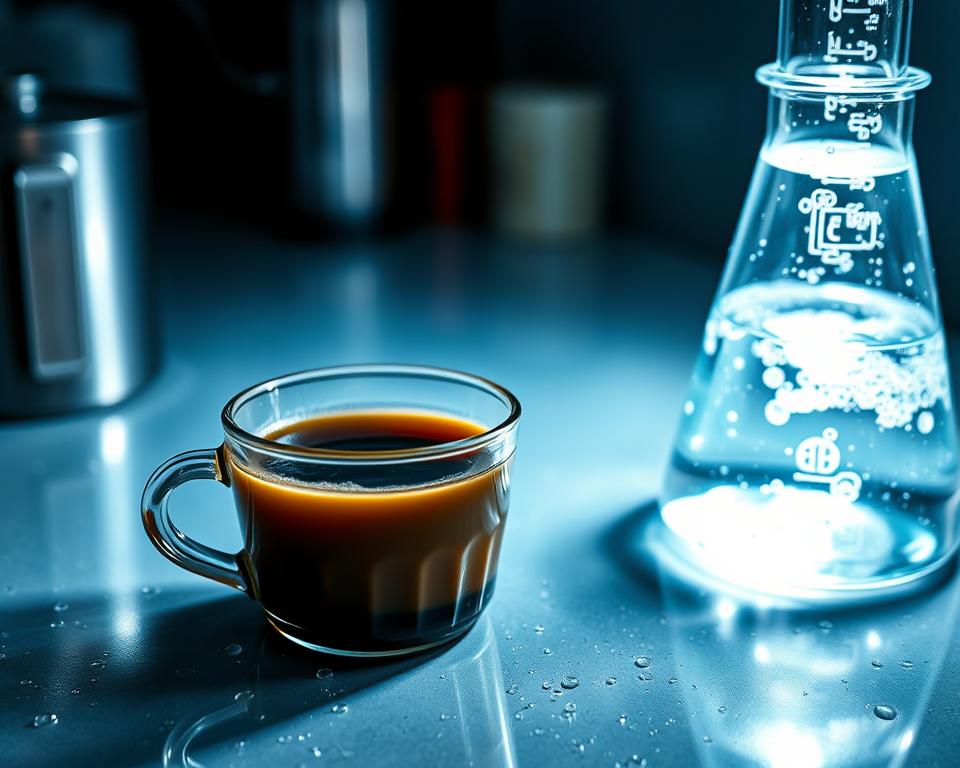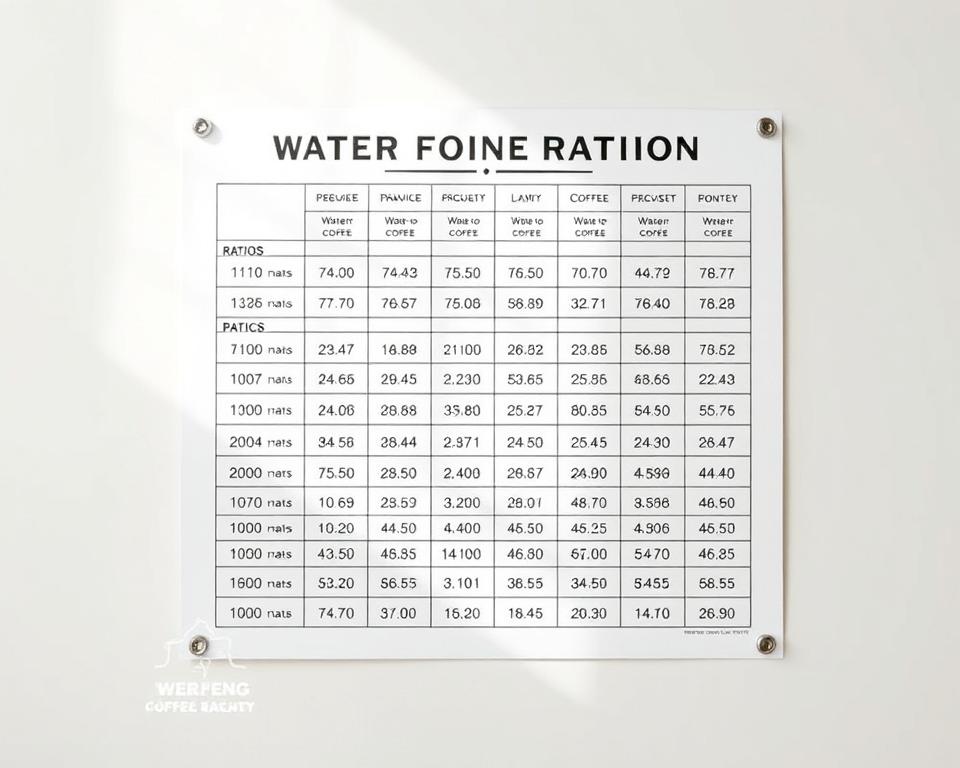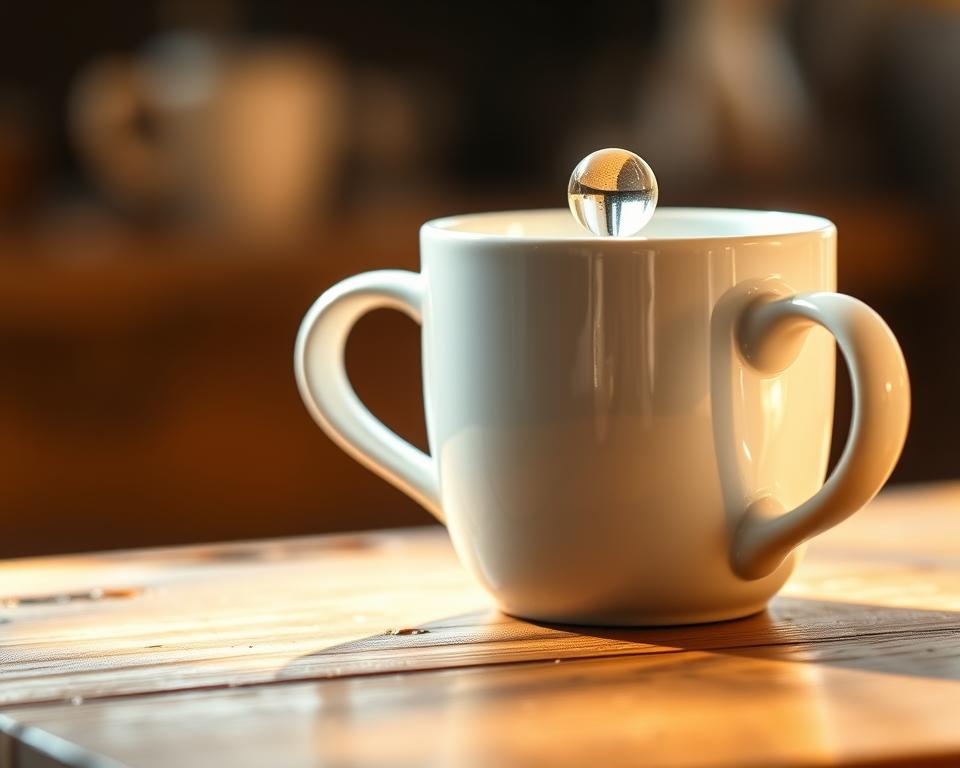Coffee’s Flavor is deeply influenced by water quality, as 98% of every cup comes from it. Impurities like microplastics or chlorine in tap water can mask coffee’s flavor notes, leaving a dull taste. Even the pH level matters: coffee’s natural acidity (pH 4.85–5.10) balances brightness and bitterness. When water pH rises above 6, it can flatten those delicate flavors.
Purified water, like that from the Bluewater Café Station™, removes 99.7% of contaminants, letting coffee’s true taste shine. The Specialty Coffee Association recommends water with 125–175 ppm Total Dissolved Solids (TDS) for optimal extraction. Too little TDS (below 75 ppm) over-extracts beans, while too much (over 225 ppm) leaves flavors underdeveloped.
Understanding water’s role starts with its purity and mineral balance. Hard or soft water alters mouthfeel, but microplastics or heavy metals disrupt even the finest coffee flavor notes. Every brew is a mix of science and art—beginning with clean, filtered water.
Key Takeaways
- Coffee is 98% water, making water quality vital for Coffee’s Flavor.
- Microplastics and chlorine in tap water can dull coffee flavor notes.
- Bluewater Café Station™ removes 99.7% impurities, improving taste consistency.
- Optimal TDS ranges (125–175 ppm) ensure proper extraction without bitterness.
- pH levels above 6 can reduce coffee’s natural acidity, altering its profile.
Importance of Water Quality in Brewing Coffee
Water constitutes 98% of every coffee cup, making it the unsung hero of your morning brew. Poor water quality can dull even the finest beans, while clean, balanced water unlocks their full potential. Understanding how water interacts with coffee grounds is key to enhancing coffee taste and refining coffee taste profiles.
Role of Water in Extraction
During brewing, water acts as a solvent, pulling hundreds of flavor compounds from coffee grounds. Minerals like magnesium and calcium boost extraction efficiency. Optimal Total Dissolved Solids (TDS) between 75-250 ppm ensure balanced extraction. Hard water (70-100 mg/L) aids flavor release but risks bitterness if over-mineralized. Soft water, when balanced, highlights delicate notes, while overly soft brews can taste thin or acidic.
- Calcium/magnesium: Enhance extraction of sweet, nutty flavors.
- Excessive hardness: Can cause over-extraction and bitterness.
- Soft water: Reveals floral or citrus undertones in lighter roasts.
Impact on Aroma and Taste
Water’s pH and mineral mix directly shape coffee taste profiles. Neutral pH (7) prevents acidity or flatness. Chlorine in tap water masks natural aromas—filtration removes these impurities. For example, espresso thrives with softened water, while pour-over brews better with slightly harder water. Test your water’s TDS and hardness to align it with your preferred brewing method.
To refine your coffee experience, explore blends designed to complement your water’s mineral balance. Regular testing with home kits ensures consistency, letting you adjust brewing methods to match water conditions.
Types of Water for Brewing Coffee
Choosing the right water type is crucial for unlocking the best coffee flavors. Different water sources impact mineral content, which affects your brew’s taste and coffee flavor classification. Let’s explore the top options for brewing excellence.
Filtered Water
Filtered water removes impurities without stripping all minerals. Carbon fiber filters neutralize odors, while reverse osmosis systems create a clean base. Many cafes add minerals like magnesium to RO water, balancing acidity and sweetness. Look for filters that retain 30–100 ppm TDS for optimal extraction.
Spring Water
Spring water contains natural minerals but varies widely. Brands like San Pellegrino have high mineral levels that can overwhelm delicate coffee notes. Opt for low-mineral spring waters, checking labels for
Tap Water
Tap water’s mineral content shifts by region. Cities like New York have mineral-rich tap water that enhances body, while others may have chlorine or hardness issues. Test your tap water’s TDS and hardness; levels over 150 ppm may require filtering. Seasonal changes in municipal supplies can alter taste consistency.
Experimenting with filtered, spring, or tap water helps match your water to your preferred coffee flavor classification. Adjust minerals thoughtfully to preserve the beans’ natural best coffee flavors without overprocessing.
How Minerals Influence Coffee’s Flavor
Minerals in water shape coffee’s taste, guiding it toward profiles found on the coffee flavor wheel. Too much or too little can shift flavors on the coffee flavor chart, making balance key. Let’s explore how minerals create the perfect brew.
Hard vs. Soft Water
Hard water (100-200ppm CaCO₃) contains more calcium and magnesium, extracting more solubles. Too hard (over 300ppm) leads to bitterness and muddled flavors. Soft water (
- Hard water: Enhances body but risks bitterness
- Soft water: Lightens acidity but reduces complexity
- Balance: 100-150ppm total hardness ideal for most beans
Essential Minerals for Brewing
| Mineral | Ion | Role |
|---|---|---|
| Calcium | Ca²⁺ | Boosts sweetness and mouthfeel |
| Magnesium | Mg²⁺ | Extracts fruity, bright notes |
| Sodium | Na⁺ | Reduces bitterness; enhances sweetness |
| Potassium | K⁺ | Smoothes acidity, extends aftertaste |
Apax Labs’ mineral blends let baristas tweak ratios for specific beans. Too much calcium (>200ppm) creates chalky flavors, while magnesium over 60ppm boosts bitterness. The right mix aligns flavors with the coffee flavor wheel’s descriptors like “citrus” or “nutty.”
Maintain TDS between 120-220ppm. Adjust bicarbonate levels (50-80ppm) to balance acidity. With these insights, even home brewers can map their brews to professional coffee flavor charts.
The Impact of Water Temperature
Water temperature is crucial in shaping coffee flavors, blending with minerals to create unique taste profiles. Mastering this detail unlocks the full potential of Coffee’s Flavor, ensuring every sip matches your preferences.
Experimenting with temperature lets you highlight specific traits in beans. Here’s how to balance heat for optimal extraction:
Ideal Brewing Temperatures
Most experts recommend 195°F to 205°F (90–96°C) as the sweet spot. This range balances extraction without scorching delicate compounds. For instance:
| Roast Type | Temp Range | Flavor Highlights |
|---|---|---|
| Light Roast | 195°F (90°C) | Bright acidity, floral notes |
| Medium Roast | 195–205°F | Smooth caramel sweetness |
| Dark Roast | 205°F (96°C) | Deep chocolate or nutty tones |
Effects of Too Hot or Too Cold
- Too Hot (>205°F): Over-extraction burns finesse, amplifying bitterness.
- Too Cold ( Under-extraction leaves sour, thin brews with muted complexity.
For precise control, use a thermometer. Traditional or infrared models ensure consistency. Adjust temps based on your water’s hardness—softer water may need higher temps to match extraction efficiency. Small tweaks here can transform how to describe coffee flavors from “overly sharp” to “balanced and rich.”
Understanding TDS: Total Dissolved Solids
Ever wondered how water chemistry shapes your cup’s profile? Total Dissolved Solids (TDS) measure particles in water, directly impacting coffee flavor notes. TDS levels between 125–175 parts per million (ppm) create the perfect extraction balance, unlocking enhancing coffee taste potential. Too low (225 ppm) causes bitterness.
What is TDS?
TDS counts minerals like magnesium and calcium dissolved in water. Specialty coffee’s solubility depends on this balance. For example, pour-over methods aim for 1.2–1.5% TDS, while espresso hits 8–12%. The ideal extraction window (18–22%) ensures sweet, balanced flavors. Go beyond 22%, and you risk a bitter finish.
Adding salts to raise TDS without adjusting mineral types doesn’t improve flavor extraction. Mineral composition matters more than total concentration.
Measuring TDS in Water
Home brewers can use pocket refractometers ($200–$1,000) to track TDS. Let’s break down key benchmarks:
- Pour-Over: 1.2–1.5% TDS
- AeroPress: 1.4–1.7%
- Espresso: 8–12%
For instance, a 320g brew with 1.43% TDS and 20g coffee yields an 18–22% extraction.
Experiment with ratios like 1:15 or 1:17 water-to coffee—pro tips for roasting enthusiasts optimizing extraction. Remember, TDS alone isn’t magic—mineral balance and grind size matter most. Adjust strategically to highlight your beans’ unique coffee flavor notes!
Chlorine and Its Effects on Coffee
Chlorine in tap water can dull coffee’s natural flavors, leaving a chemical aftertaste. The Specialty Coffee Association recommends keeping chlorine under 60ppm. Levels below 30ppm are ideal to protect equipment and preserve best coffee flavors. High chlorine levels mask acidity and sweetness, altering coffee taste profiles with notes reminiscent of a swimming pool.

“Chlorine’s sharpness can overpower coffee’s delicate aromas,” say baristas at top roasteries.
Detecting Chlorine in Water
Identify chlorine through:
- Smell: A sharp chemical odor in water
- Taste: Metallic tang or bitterness
- Test strips: Measure ppm levels directly
These clues reveal chlorine interference, which suppresses nuancedcoffee taste profiles.
Reducing Chlorine Levels
Neutralize chlorine with these steps:
- Aeration: Let tap water sit uncovered for 24 hours to let chlorine gas escape.
- Carbon Filtration: Activated carbon filters (like the AquaTru Classic) trap chlorine and chloramines, preserving flavor clarity.
- RO Systems: Reverse osmosis units remove 99% of contaminants, unlocking the best coffee flavors hidden by municipal treatment chemicals.
Regular filter changes ensure consistent results, letting coffee’s origin notes shine.
The Role of pH in Coffee Flavor
Exploring how pH influences coffee’s taste begins with its chemical foundation. Coffee’s pH, ranging from 4.5 to 6, plays a crucial role in defining its coffee flavor classification. For instance, light roasts (pH ~4.8) bring out bright citrus notes, whereas darker roasts (pH ~5.3) introduce nutty depth. Research indicates that pH affects extraction, with alkaline water (pH 7-8.5) enhancing solubility and revealing complex flavors. Yet, pH levels above 8.5 can lead to sour tastes and equipment damage.
Understanding pH Levels
Acidity in coffee comes from organic acids like citric and malic, which pH levels balance. A pH below 5.5 intensifies tartness, fitting coffee flavor wheel descriptions like “bright” or “winey.” At pH 6+, flavors transition to chocolate or caramel. Here’s how pH influences flavor profiles:
- Light roasts (pH 4.8): Acidic, fruity, and floral notes
- Dark roasts (pH 5.3+): Smookier, less acidic
- Cold brew (pH 6.0-6.3): Reduced acidity, smooth mouthfeel
Optimal pH for Brewing
For balanced extraction, aim for water pH between 7-8.5. This range increases solubility of chlorogenic acids, preserving bright acidity in light roasts while preventing bitterness from over-extraction. For example:
“Higher pH water enhances clarity in high-altitude coffees like Kenya AA, showcasing their trademark blackcurrant acidity.”
| pH Range | Flavor Impact |
|---|---|
| 4.5–5.0 | Citrus, berry, or winey notes |
| 5.1–6.5 | Smooth, balanced acidity with nutty or caramel tones |
| 6.6–8.5 | Reduced acidity, chocolatey or toasted flavors |
Adjusting pH alongside grind size and roast can refine your coffee flavor wheel preferences. Experimenting with slightly alkaline water (pH 7-8) can highlight the unique terroir of beans like Ethiopian Yirgacheffe or Sumatra Mandheling. Remember, pH interacts with water hardness and brewing method—test pH kits to refine your brew’s character.
Water-to-Coffee Ratio
Mastering the water-to coffee ratio unlocks a world of flavor nuances. Begin with the golden ratio of 1:16 to 1:18 for drip coffee, balancing acidity and body. Adjustments are crucial—mineral-rich water may need less coffee, while soft water might require a higher ratio to avoid bitterness. Every brew method has its sweet spot, so experiment with scales for precision.

Discover how ratios shape your cup’s character. A coffee flavor chart reveals how lower ratios (e.g., 1:14) amplify bold, roasted notes, while higher ratios (e.g., 1:20) highlight citrus or floral acidity. Use this knowledge to how to describe coffee flavors with precision, noting whether your brew feels “bright” or “velvety.”
- Pour-Over: 1:16 (balanced) to 1:18 (light-bodied)
- French Press: 1:15 (creamy) to 1:17 (clean)
- Espresso: 1:2 (intense) or 1:3 (sweeter)
- Cold Brew: 1:6 (bold) to 1:8 (mellow)
Adjust ratios based on your water’s mineral content. Hard water’s minerals boost extraction, so try 1:17 if your tap water is high in calcium. For soft water, a 1:14 ratio might prevent under-extraction. Keep tasting notes handy to match your preferences to the coffee flavor chart—your go-to guide for naming flavors like “citrusy,” “nutty,” or “chocolatey.”
Brewing Methods and Water Quality
Choosing the right water quality for your brewing method can significantly enhance coffee flavor. Each brewing technique responds differently to water’s mineral content, pH level, and filtration. Here’s how to adjust water quality for your preferred brewing method:
Espresso vs. Drip Coffee
| Brewing Method | Ideal Water Hardness (ppm) | Coffee Flavor Notes | Best Water Type |
|---|---|---|---|
| Espresso | 50–80 | Cocoa, caramel, rich body | Filtered (low mineral) |
| Drip Coffee | 100–150 | Citrus, nutty, balanced | Filtered or spring water |
Espresso machines require soft water to avoid scaling issues. Drip coffee, with its longer brew time, can handle more minerals but still benefits from clean water. Both methods benefit from removing chlorine.
French Press Considerations
French press brewing excels with slightly harder water (150–170ppm):
- Minerals like magnesium enhance body and sweetness.
- Soft water (50–100ppm) brings out floral or acidic notes.
- Use filtered water heated to 195–205°F for even extraction.
Adjust water quality based on your desired coffee flavor. A medium-hardness balance often yields the best full-bodied French press results.
Tips for Optimizing Your Water Quality
Water constitutes nearly 98% of your coffee, making small adjustments crucial. To enhance your coffee’s taste, first grasp your water’s chemistry. Utilize tools like a $10 TDS meter or pH strips to monitor mineral levels and acidity. These metrics guide adjustments to your brewing method and coffee bean selection.
Testing Water at Home
Start with a basic TDS meter to gauge dissolved solids. The Specialty Coffee Association (SCA) recommends a TDS range of 120–130 ppm for balanced extraction. Use pH strips to aim for a neutral pH of 7.0, avoiding extremes that can mute flavors. Home kits can measure hardness, aiming for 70–80 mg/L to prevent over- or under-extraction. Be aware that municipal water hardness can change with the seasons.
Recommendations for Great-Tasting Coffee
Soft water, with a TDS of 200 ppm, benefits from reverse osmosis (RO) systems. These systems remove excess minerals and add back calcium/magnesium. Use Brita pitchers to remove chlorine, which can mask aromas. For dark roasts, choose water under 100 ppm TDS to avoid bitterness. Light roasts, on the other hand, prefer spring water with 10–30 ppm magnesium to enhance fruity notes. Always descale machines every 8–10 weeks if using hard water to prevent buildup.
By experimenting with these steps, you align with coffee flavor classification standards. This ensures each brew showcases the bean’s natural profile. Even minor tweaks, like using RO water with remineralization tablets, can significantly improve results. Remember, consistency is key. Start with small changes, track them, and enjoy the clear, balanced water’s impact on every cup.
FAQ
How does water quality affect the flavor of my coffee?
What type of water is best for brewing coffee?
How does the hardness of water affect coffee extraction?
What minerals are essential for brewing great coffee?
What temperature should I brew my coffee at?
What is TDS, and why is it important for coffee brewing?
How can I tell if my tap water has chlorine?
What is the optimal pH for brewing coffee?
How do water-to-coffee ratios affect my brew?
Do different brewing methods require different water qualities?
What are some easy ways to improve my home water quality for brewing?

Paul Allen is a writer at WyNeeds, a website dedicated to the world of coffee. Passionate about aromas and flavors, he explores everything from the best brewing methods to fascinating insights about coffee beans and industry trends. His goal is to provide readers with engaging and informative content, helping both beginners and coffee enthusiasts deepen their knowledge of the world’s most beloved beverage.

